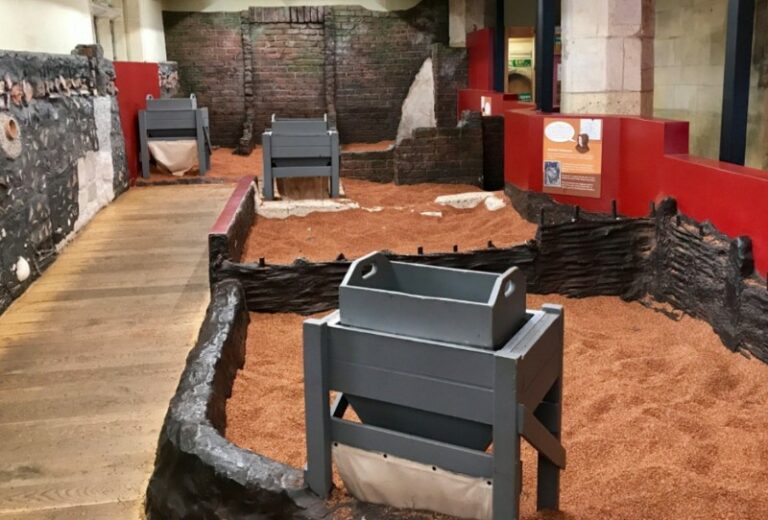
York Castle Museum - Main Entrance

York Castle Museum - Kirkgate Victorian Street

York Castle Museum - Shop

York Castle Museum - Chocolate York\\\\\\\'s Sweet Past

York Castle Museum - House Interior

York Castle Museum - Prison

York Castle Museum - The Sixties Kitchen

York Castle Museum - The Sixties

York Castle Museum - Toy Stories

York Castle Museum - Victorian Street
The York Castle Museum was founded by Dr John Kirk in 1938, a doctor from Pickering, North Yorkshire. The museum showcases his extraordinary collection of social history reflecting everyday life in the county. Travel back in time at one of the museum’s most popular displays, Kirkgate, a reconstructed Victorian street.
York Castle Museum Exhibitions
The York Castle Museum is housed in the Grade I listed former debtors prison and an adjoining former women’s prison. The museum’s name comes from the fact it stands on the site of the former York Castle. Take a journey of discovery to Kirkgate, a reconstructed Victorian street. Soak up the sights, sounds and smells of Victorian York as you explore its cobbled streets and alleyways. Visit shops packed with fascinating objects, from luxurious costumes to traditional sweets. There are a number of exhibits for you to view from the luxury of the rich to a darker world of poverty and disease. Witness how Yorks 19th century residents lived, learned and entertained themselves.

Kirkgate – The Victorian Street
Explore the life of the rich and poor at Kirkgate – The Victorian Street, located within York Castle Museum. The street includes a number of authentic York businesses. Both the facades and their interiors are as authentic as possible with thousands of goods on display. Its schoolroom, police cell, Hansom cab and cobbled street surface all remain. Every single shop on the street is based on a real York business, all of which operated here between 1870 and 1901. The costumed guides can tell you more about each shop when you arrive.
The Shops
Visit shops, like Banks Music and Sessions Printers, which are names still operating in the City today. See some of the fascinating goods for sale which have disappeared from our high streets today. The wide variety of stores includes Little Dust Pan Ironmongers, Kendrick’s Toy Dealers and Fancy Repository, and the Plummer Sisters Milliners.
There is a wide mixture of stores. Some sold to the rich, like George Britton’s grocers, importers of fine teas and coffees. Thomas Ambler’s grocers sold to the working class.
The Poverty
There is an alleyway off Kirkgate, called Rowntree Snicket, which aims to portray the poverty of Victorian York. Rowntree Snicket includes a working-class home and was inspired by Seebohm Rowntree’s survey of York’s poor. This survey led to his ground-breaking report, Poverty: A Study of Town Life, published in 1901.
The People
There are a number of people you can meet at Kirkgate and the surrounding alleyways. These include:
* Mary Sessions – a widowed shopkeeper, an entrepreneur and a Quaker.
* Isaac Dickinson – he grew up in a slum, worked at Terry’s Chocolates, campaigned for shorter hours and helped bake a Royal cake
* Tempest Anderson – a medical doctor, a climber, explorer and local celebrity
* Mabel Smorfit – daughter of a railway worker, school child who did well at her lessons, and a proud owner of a new bicycle
* Thomas Frederick Earnshaw – he started work as a child, was a successful apprentice who won a prize for his workmanship and rang the bells at the famous York Minster
* Elizabeth Kidd – a bootmaker’s daughter, housemaid, mental health worker and photographic model
* George Alp – a teenage dad who moved cities to become a policeman, often drunk but commended for catching a thief
York Castle Prison
York Castle Museum is housed in the 18th-century prison buildings. Visitors can get a flavour of what life was really like in the original cells and see some of the most infamous inmates brought to life in this fascinating exhibition. Experience a brutal and crooked prison and meet the most notorious prisoner, the legendary highwayman, Dick Turpin.

York Castle Prison focuses on the lives of eight former inmates, including Dick Turpin. Other featured inmates include the last woman to be burnt at the stake in Yorkshire, a Luddite, a notorious turnkey, a man who was beaten so badly in prison he died and a young tearaway who went on to lead a successful life in Australia. Check your family name against the database of former prisoners and victims.
York Castle has been a site of justice and incarceration for almost 1,000 years. William the Conqueror built the first castle in 1068 which included a prison. The site is still a seat of justice today. York Crown Court now occupies the 18th Century Courthouse and holding cells. People accused of serious crimes are still tried there as they have been for almost 1,000 years.
Chocolate – York’s Sweet Past
Take a journey through York Castle Museum and delve into the delicious history of some of the world’s most iconic chocolates and sweets. Discover more about the family favourites that were first created in the City of York. Visit the sweet shop on Kirkgate and view the displays of original adverts, packaging and more as you immerse yourself in the stories of those who took York’s lifelong love of confectionary to the world.
Start your chocolate journey from the museum’s Period Rooms to discover how the Georgians, Victorians and the Jacobeans satisfied their sweet tooth. Follow the steps to find a spectacular whizzing and fizzing sweet making machine in the Toy Gallery. See what’s cooking in the working Chocolate Factory where you can explore what it was like to work in York’s famous factories.
1914 – When the World Changed Forever
This major exhibition marking the centenary of the First World War highlights the terror of total war and its revolutionary impact on life globally. Starting in the pre-war golden age of peace and prosperity, visitors are sent to the recruitment office where they travel via train to the horrors of the frontline. Back home, daily life in Britain was changing beyond recognition while around the world millions would die as Europe’s empires clashed in the first truly global conflict.
New technology and research are combined with the museum’s extensive military, costume and social history collections to tell the fascinating and often moving stories of the Yorkshire people who lived and died during the war that they said would end all wars.
Shaping The Body – 400 Years of Fashion, Food and Life
An iron corset, crotchless pantaloons from the time of Jane Austen, bum rolls and a killer dress are a few of the items featured. This exhibition charts the way fashion, food and fitness have shaped the body over the last 400 years.
Changing fashions occupies the main gallery of the exhibition. The artefacts range from 18th-century dandies to the contemporary alternative fashion and body modification scene. Explore the relationship between food and body shape in the second gallery.
The final section of the exhibition takes this exploration one step further to look at how bodies are shaped by daily lifestyle, comparing the more physically arduous lives of housemaids and farmhands before the advent of modern domestic gadgets and agricultural machinery, with their contemporaries to understand why modern average body shapes and sizes are so much larger.
The Sixties
The Sixties exhibition aims to recreate the spirit of this exciting decade which saw a momentous change in so many areas of public and private life. The gallery uses fascinating and iconic objects from our social history, art, fashion, military and astronomy collections to bring back the atmosphere of change which swept over the country during the 1960s. Highlights include a Lambretta scooter, a Dansette record player, Beatles singles and fashion by Mary Quant.
Using visual design and colour schemes influenced by the trends of the decade, it explores key themes such as fashion, music, the home, sport, childhood, the Space Race, free love, counterculture and women’s liberation.
Household exhibits include food packaging, clothes, electrical items, toys, records and more. Visitors can listen to memories of the decade via special telephones, listen to music on a Jukebox and watch television and film footage from the time. There is also a replica of the Mercury space capsule which you can climb inside.
Toy Stories
Take a trip back to your childhood and rediscover some of your favourite toys in this popular exhibition. Dating back 150 years, the toy collection includes bikes, bath toys, computer games, Lego and beautiful handmade dolls. Play together in the exciting Castle-inspired play area. Watch the 100-year-old carousel, or head off on the children’s Teddy Trail.
Raindale Mill
Relax in the peaceful riverside area where you can explore the bank of the River Foss. Discover more about life in a Victorian watermill and admire the ruins of the walls of York Castle. Raindale Mill, a Victorian watermill was brought to York in the 1960s from the North York Moors where it served Newton-upon-Rawcliffe and the surrounding villages. The mill has been brought back into working order with trained volunteers operating the waterwheel. Please contact the Museum in advance of your visit to find out when the wheel will be in operation.
Cafe 68 at York Castle Museum
Open daily until 4.30pm, you are also welcome to visit the cafe without paying admission to the museum. At Cafe 68, they serve delicious lunches, homemade cakes and their own house blend coffee with options for special diets and kids. The varied menu is perfect for filling hungry kids and grown-ups and they also do hot drinks and some food to take away.
The family-friendly Cafe has huge windows looking out to Clifford’s Tower (one of York’s most famous views).
Admission Prices and Offers
The York Castle Museum is part of the York Museums Trust. Children under the age of 17 go free to all of the York Museums Trust attractions. You can purchase your tickets at the attraction, view the official website for details.
Travelling to York Castle Museum
York City centre is encompassed by its ancient walls and is accessible on foot. York Castle Museum is in the centre of York, close to Clifford’s Tower and the Coppergate Shopping Centre. The nearest car park is the Castle car park next to Clifford’s Tower. It is only a short walk from one end of the city to the other.
Travelling by Train
York Castle Museum is approximately a 25-minute walk from York Railway Station. When leaving the station, follow the green pedestrian signs to the ‘Castle Area’. York Railway Station has great links to Leeds, Harrogate and the East Coast. Search for your train tickets using See the Raileasy website.
Travelling by Coach
Visit National Holidays if you want to travel by coach to York.
Nearby Accommodation
There are lots of places to stay in and around the city of York. Find hotel accommodation at Hotels.com or Travelodge and Britannia Hotels are always a good option for budget hotel accommodation.
If you prefer self-catering, check out some of the lovely places to stay on the outskirts of the City of York on Snaptrip.
Attractions Near Me Offers
For the best deals and Discount Days Out visit our Offers page Attractions Near Me
Also like our Facebook page for notification of any new offers Facebook.com/AttractionsNearMe
Sorry, no records were found. Please adjust your search criteria and try again.
Sorry, unable to load the Maps API.














